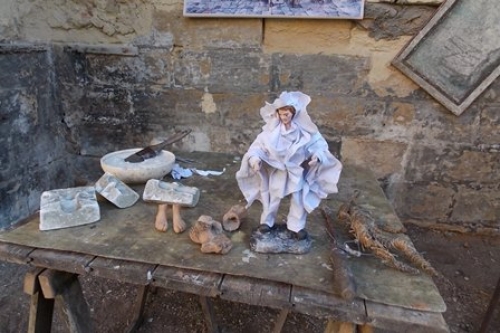Do you remember art projects as a child that involved strips of newspaper and paste made from flour and water? The practice of the cartapesta (paper mache) has been an art form in Lecce, Italy for centuries.
Used as an inexpensive substitute for plaster, stone or wood, paper carvings were popular for church statues and embellishments. A multi-step process that is now duplicated by machines in competing countries, Lecce continues to celebrate skilled artists of cartapesta.
Yle Sambati (yltourcongressi.com.it) arranged my private visit to meet maestro Baldari in his city labororatorio.
On a quiet street near the center of Lecce, I entered a stone gateway to a large open courtyard. The space was set up as a small assembly line where the entire family worked to produce the paper and the figurine or ornament that would become a family or church treasure.
My focus went to the large caldron of white material that resembled overcooked rice. Quickly I learned this mixture would turn into paper sheets via dipping a cascio, a wooden frame with a mesh center, into the gelatinous mixture. The cascio traps the fibers and a sheet of paper is formed. Each piece of paper is removed by hand and placed on a sheet of wool felt. Paper is alternated with felt until you have a stack. The stack is pressed in an ancient wood press to remove the remaining water. Drying on a clothes line is the final stage.
As I watched, Signora Baldari used the dried sheets of paper to quickly create a figurine with a flowing robe and a mantle (shawl); her fingers quickly folding and tucking paper to create the resulting angel. The paper is crafted around skeletons made from wire. Ceramic heads, faces and hands can be used with the wire framework.
Iron rods of different sizes (similar to a curling iron) are heated in a brazier. Once glowing, the rods are used to shape, color and burn the paper clothing. Each figurine will be unique once painted and finished, resulting in a piece of art that is the perfect souvenir to bring home from Italy.
Maestro Baldari has passed on his skill to his son so the tradition will continue. His son told me there is a lot of competition from other markets, but the Baldari creations are in demand from foreign buyers who appreciate the skills and beauty of handmade art. I only hope the younger generation of Italians continues to accept their place in family businesses so that we may all enjoy the treasures of Italian hand-crafted products.



